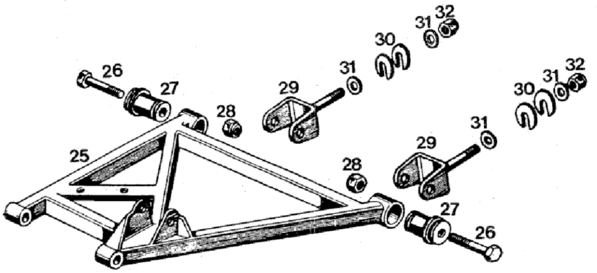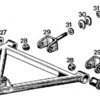IMHO, removing all the adjusting shims AND the stock washers still may not bring the lower a-arm in far enough. What's happened is, the spot-welds holding the whole rear of the Pantera monococque together have loosened/shifted/ broke, enough that the alignment has changed beyond factory adjustment limits. PLEASE DO NOT do what one owner did to get more adjustment- he lathe-cut the bracket/stud welds back to thin the part that holds the entire rear of the car up off the ground!
The stock upper brace-bar doesn't help much either because the tab-holes are oversized and slotted and the tabs are too thin to deal with the forces involved in cornering with big, modern sticky tires. So the bar & bolts shift back & forth. You cannot tighten the Grade-5 attach bolts enough to hold an adjustment without breaking them, or cracking the light metal tabs.
Two solutions: a very few Pantera-specific shops have the capability to rebuild the entire rear sheet metal monococque to factory-blueprint alignment using torches & hydraulics. Then, you should install an upper brace-bar that has long enough ends to protrude inside the stock mount tabs, reaching to the backside of the upper shock mounts, and snug it up. This bar (pioneered by Hall Pantera but now repro-ed by many others) has a large threaded clevis & jam-nuts to absolutely hold it's adjustment. So the little stock tabs now only hold the bar in position while all suspension and big-tire cornering loads are taken by the bar, the upper shock-mount weldments & the inner fender stampings.
A second possibility, if your car is not too badly distorted by age & use: jack up both rear wheels, install the heavy-duty upper brace-bar with clevis as above, and crank in "some" preload but NOT all the car needs at one time! Tighten the jam nuts and drive it around for a while, then measure what your camber is now. Repeat as required until you're satisfied. This gives the sheet metal time to 'shift back' towards blueprint specs without warping the body, inner & outer fenders etc. Major body damage can occur if you get impatient! Our '72 had slightly over 1 degree negative camber, and in three adjustments over the course of a week of adding progressively more pre-load, then driving around town, I managed to pull the rear camber back to zero with no body distortion. That was in 1990- YMMV.
To overkill the problem, I also hand-made four little oval pieces of 1/8" thick metal with a hole in them, that tightly fill the slotted mount holes in the tabs while being a snug fit on the mount bolts going thru them. Washers on both ends of the tab bolts keep the filler pieces, bolts and brace-bar from shifting around at all. You can verify this by spray-painting the tabs & bolts after assembly; spray-lacquer is quite brittle and will crack if anything moves, giving an easy visual check without needing real one-use-only torque paint.
I also made similar filler pieces for the slotted holes in the front upper a-arm mounts to hold my chosen front camber setting, without the expense or complication of fixtures, bolts & lock-nuts. Obviously, I don't readjust front camber very often as each setting would take different fillers! They have worked for decades to hold my chosen settings over thousands of road miles- even autocrossing with gumball racing tires one season.



